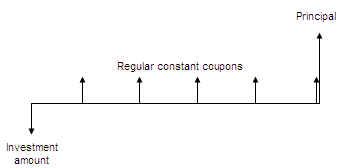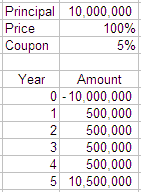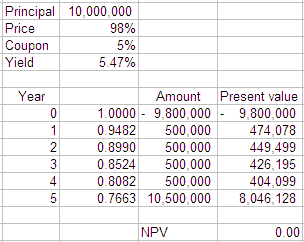
Barbican Consulting Limited
Fixed Coupon Bonds

Introduction
A bond is a long term debt obligation. It is sold by the borrower who is called the "issuer" in order to borrow money for the medium and long term. Typically a bond will have a maturity of between 2 and 20 years. The issuer can be a bank, company or government institution. A bond normally has a known maturity or redemption date and during its life pays the investor interest. The interest payments are called "coupons".
Bond investors rank prior to equity holders in liquidation but are subordinate to secured lenders. From an issuer’s perspective, the coupons are usually tax deductible (unlike dividend payments on equity). Bond markets provide investors with variety. One of the most frequently issued bonds is called a fixed coupon bond. This is also referred to as fixed income security or fixed rate bond.
Fixed coupon bonds
Fixed coupon bonds pay a fixed or known coupon to the investor. The coupon payment is normally made annually or semi annually although some bonds pay quarterly coupons. For fixed coupon bonds the interest payments are set at the time the bond is issued. This means that an investor knows exactly what payments he will receive and when he can expect to receive them. It is this certainty that attracts many investors who have corresponding liabilities they need to pay in the future. On the maturity or redemption date the principal amount of the bond is repaid. Investors can find out about the coupons and repayment date by referring to the bond's information memorandum or term sheet. From the investor's perspective the cash payments on a simple 5 year bond would be as follows:

If this bond had a principal amount of $10,000,000 and a 5% coupon then the cash payments would be as follows:

The investor pays $10,000,000 to buy the bond, receives a regular $500,000 coupon and has the $10,000,000 returned at the end of the fifth year. For fixed interest bonds the coupons are normally paid on a "bond basis" this assumes 12 months per year each month having 30 days (irrespective of whether a month really does have 30 days in it). This can make the calculation of accrued interest a little tricky particularly when there are several different conventions concerning the treatment of accrued interest over month end.
The bond price
In our example the bond price is 100% (sometimes referred to as "par"). When dealers buy and sell bonds the price they agree can be above or below par. This is straight forward. If our bond traded at 102% the investor would pay $10,000,000 x 102% = $10,200,000. If the bond traded at 98% the investor would pay $9,800,000.
Why this happens is a little more complicated. It is to do with the bond's value. A bond that pays a high coupon when interest rates are low will normally have a price greater than 100% (because it offers a high level of investment income relative to current interest rates). Bonds with coupons lower than market interest rates will tend to have prices below par. Of great importance to the price of the bond will be its perceived credit risk. If the credit risk of a bond increases (investors fear there is more chance of a loss occurring from default by the issuer) then the price of that bond will fall to compensate the investor for the risk being taken.
When bonds are traded dealers agree the "clean price" this excludes any accrued interest on the bond. When the trade is settled the operations department takes the clean price and adds the accrued interest to it. This total becomes the settlement amount which is also called the "dirty price".
The accrued interest is the interest amount that the bond has accumulated since its previous coupon payment. In effect the bond purchaser is paying for the accrued interest to date and will receive this money back when the next coupon is paid.
Here is a quick example. Suppose the coupon was $500,000 and the bond was sold exactly half way through a coupon period. The accrued interest would be $250,000:

This would then be added to the clean price agreed between the dealers in order to obtain the settlement price.
Judging value
When an investor buys a fixed coupon bond he is really purchasing a series of cash payments which are the direct obligation of the issuer. This means the investor has a credit risk on the issuer for the timely payment of the coupons and principal repayment.
Investors and traders judge the value of a fixed coupon bond by calculating its yield to maturity. This is the bond's internal rate of return. It is the rate of interest that when used discounts all the bond cash flows to give a net present value (NPV) of zero. The higher the yield the greater is the rate of return. An example shows the relationship between a bond's price and yield.
This bond has a price of 100% and a yield of 5.00%:

This bond has a price of 98% and a yield of 5.47%:

This bond has a price of 102% and a yield of 4.54%:

These three examples clearly show that the lower is the price the higher is the yield. That's because you obtain the same interest payments but pay less for them at the start.
To fully evaluate whether the bond is good value an investor must consider its risk. The main risk is credit risk and bonds with higher credit risk normally provide investors with greater yields.
Dealers use yield as a means of making comparisons. In theory two bonds of similar maturity and risk should have similar yields. In practice this doesn’t always happen. Some bonds can be relatively cheap (higher yield) and some relatively expensive (lower yield). Traders are keen to exploit these differences buying cheap bonds and selling expensive ones. This is sometimes called "relative value trading".
Interest rate risk
Fixed coupon bond prices are strongly influenced by interest rates. When interest rates increase the price of fixed income bonds falls, this is because the interest and principal cash flows they represent are discounted at a higher rate.
This loss in value is more pronounced for longer dated low coupon bonds. They present the investor with greater interest rate risk. For this reason an investor in fixed coupon bonds should be aware of the level of interest rate risk that is being run. There are several quantitative techniques that can be used including duration, basis point value and value at risk.
First Published by Barbican Consulting Limited 2010